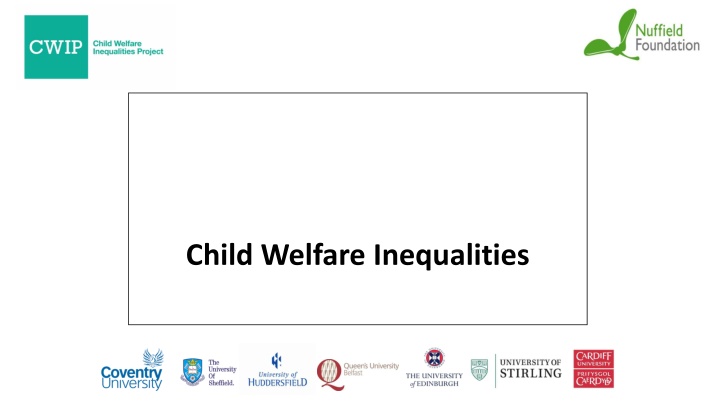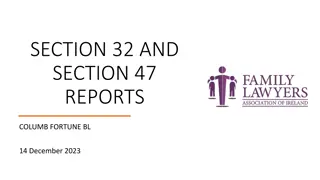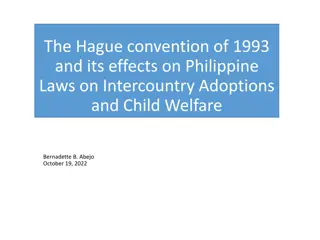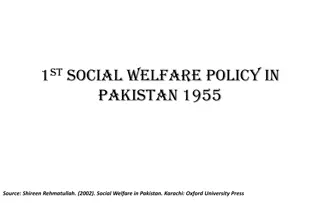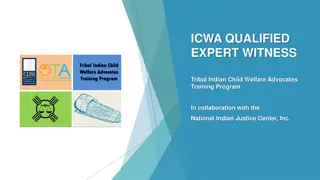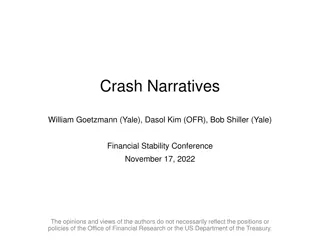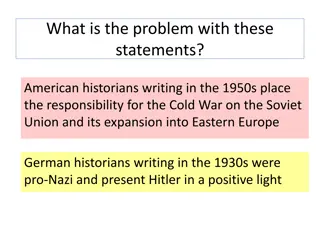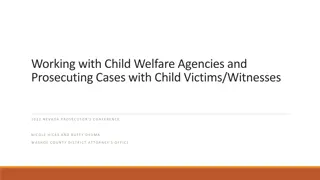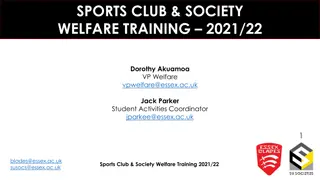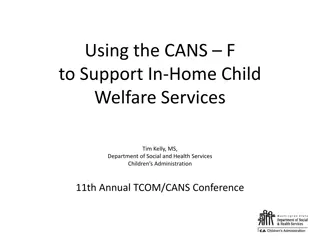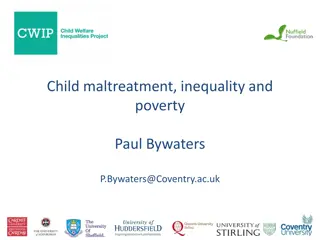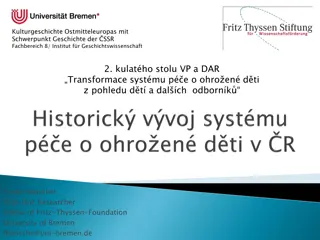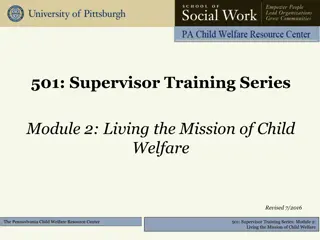Rethinking Stories in Child Welfare: Promoting Evidence-Based Narratives
The narrative surrounding child welfare often portrays parents as victims of societal factors, neglecting individual agency and responsibility. Two contrasting stories emerge in the discourse: one focusing on blaming poverty for child abuse, and another emphasizing the role of parental actions in neglect and harm. The need for evidence-based, value-driven stories in the child protection system is highlighted to address these inequalities and misconceptions.
Download Presentation

Please find below an Image/Link to download the presentation.
The content on the website is provided AS IS for your information and personal use only. It may not be sold, licensed, or shared on other websites without obtaining consent from the author.If you encounter any issues during the download, it is possible that the publisher has removed the file from their server.
You are allowed to download the files provided on this website for personal or commercial use, subject to the condition that they are used lawfully. All files are the property of their respective owners.
The content on the website is provided AS IS for your information and personal use only. It may not be sold, licensed, or shared on other websites without obtaining consent from the author.
E N D
Presentation Transcript
The power of stories Stories are the means by which we navigate the world. They allow us to interpret its complex and contradictory signals (Monbiot, 2017). All compelling stories tend to have a plot, feature victims and villains, have a moral, and appeal to particular values We argue that parents in the child protection system deserve better stories than those currently in circulation We need to develop compelling stories rooted in evidence and appeal to alternative values than those dominant currently
Whats the story? In too many cases, social work training involves idealistic students being told that the individuals with whom they will work have been disempowered by society. They will be encouraged to see these individuals as victims of social injustice whose fate is overwhelmingly decreed by the economic forces and inherent inequalities which scar our society. This analysis is, sadly, as widespread as it is pernicious. It robs individuals of the power of agency and breaks the link between an individual s actions and the consequences. It risks explaining away substance abuse, domestic violence and personal irresponsibility, rather than doing away with them.
Story One Child protection is a specific activity that is largely concerned with stopping children dying or being harmed/neglected by their parents or carers Many parents and carers make dangerous or poor lifestyle choices. They choose violent men and/or to waste their money on drink and drugs. They are able to outwit gullible social workers who, though well-meaning, are let down by social work educators These educators tells them not to blame or condemn parents, but rather to see them as victims of poverty or inequality But poverty and inequality have nothing to do with child abuse
Story Two Child abuse and neglect is caused usually by parents or carers doing, or not doing, things to others A key part of the professional task is to assess for, and deal with, risk in families and in communities Poverty does not cause abuse and neglect but impacts on parenting because of the stress it causes. Most poor parents do not abuse their children Child protection and welfare are recognised as linked but the link is poorly understood and relatively under-explored Early, time limited, interventions are vital to mitigate against brain damage or faulty attachment patterns developing
Telling a different story? Children Looked After per 10,000 Aged 0-17 - Published Data. Glasgow, Scotland Blackpool, England Torfaen, Wales Belfast, N. Ireland East Renfrewshire, Scotland Pembrokeshire, Wales Southern HSCT N. Ireland Wokingham, England 0 50 100 150 200 250 300 350
CLA not at home or with relatives or friends by Deprivation Quintile, UK Countries, 2015 200 Rates per 10,000 children 180 160 140 120 100 80 60 40 20 0 1 2 3 4 5 ALL NI 17 29 31 48 35 England 13 26 35 61 112 52 Wales 10 19 35 57 135 62 Scotland 18 34 45 82 188 82
120 UK CPP Rate by deprivation LA group and neighbourhood deprivation quintile, 2015 100 80 Rate per 10,000 children 60 40 20 0 1 2 3 4 5 6 High IMD 4 12 23 36 78 48 Low IMD 10 21 39 60 107 32
The Case Studies The Case Studies Two overarching questions 1. What is the interplay between decisions to intervene in children s lives and their social, economic and material circumstances? 2. Can we confirm and investigate the inverse intervention law ? Finer grain questions 1. Professionals 2. Resources 3. Families
Unmet need and rationing It s a high threshold service we are working with some of the most vulnerable children in the city, we re working with children who are subject to CP registration, who are subject to compulsory measures of care through the children s hearing we are working with children who are most at risk . The staff at the site explained that the threshold is too high and that it s [social work] become a crisis service more or less. During observation of a referral meeting, the staff during the (1 hour) meeting worked through a waiting list of 63 children. The bulk of them were defined as other children in need whilst 8 were headed child protection . The IIL site team manager explained that demands and expectations have just increased, increased, increased, increased
The consequences of change The duty team leader described the restructuring as unsettling as you are merging into already formed teams . She explains moving between offices is difficult because you have to sustain knowledge of local resources, which are constantly changing, and it can have an impact on understanding of thresholds as it can vary between localities sometimes . During fieldwork a C&F social worker described the restructuring as localities getting smaller but the geography is getting bigger you are covering a wider area .
Witnessing inequality there are areas in this map which you know, is proper inner-city . You are talking terraced houses, narrow streets, you know, rubbish in the streets, kids playing and things like that. But then again, you go to somewhere like XXXX, which is within that area, affluent, detached houses, and front, and rear gardened, manicured fences and lawns and stuff like that. So yeah, it s within walking distance of one another, two different worlds aren t they?
Reflections on sites of practice Where I tend to notice it most, when you have incoming conferences you tend to notice it most, they tend to go to certain areas and I think that's probably because certain areas have poor housing. So if you are moving in you can get a house easier there than elsewhere and some of our people, erm, aren't good tenants unfortunately, so they tend to get the housing that maybe wouldn't be enough for the likes of you and me, if we were looking for housing. So they tend to move to certain parts of the city and that in itself then... But then again even just working here I think it s easy to identify where the more deprived areas are in XXX P4: It s all the same roads isn t it? P2: Yeah, yeah. P4: There is probably a dozen roads where you get something through and you just go urgh P3: Not there again
Core business We also do a lot of signposting families to foodbanks, or we can issue foodbank vouchers. But we tend, if we can, we are more than fully committed doing what we would consider our core business, which is doing parenting skills, parenting capacity change type of things. And this other stuff, whilst in a perfect world we should be doing it, and doing it with family, the reality is that the work load people would say "you need to be doing other things, getting other people to do that sort of thing for them, you can't, you haven't got the capacity and if you do it you run the risk of drowning".
Who is in poverty.. But then how are we meant to support children that are in poverty? You know when I was studying years ago, 2007 there was like this great big child poverty campaign that all children would be out of child poverty by 2010. You know there was going to be all these children s centres, Every Child Matters agendas. You know, things were going to change and then they didn t... so I feel like we re deprived. We re working in an industry where our resources are deprived. We re in poverty!
The links between poverty and harm Yeah I mean I think there is a link between say deprivation and alcohol misuse because I think it s a coping strategy and I think then that, if you re in heights of stress then that probably increases the chances of DV within families. So I think there are links absolutely between those sorts of things. Deprivation and the pressure is causing problems in relationships and is causing the family to struggle to meet the children s needs We have people coming in with no money, or to get food bank vouchers. Erm, yeah and then I suppose it s the downward spiral so you get a lot of the toxic trio so people turning to drink and drug use.
Detaching poverty from case work You can give these families 1million and they will still have the same issues. They will still be in the CP system. It s got nothing to do with deprivation Poverty is the outcome not the cause. You do see some good reports and financial circumstances are mentioned in these, or home conditions, or having fled in a time of crisis. But setting the child s needs in the overall macro political context of XXXXX whether you are reliant on benefits or availability of shops, that doesn t happen, I don t see it happening as a matter of course. Poverty is looked at as part of a spectrum of issues that we could look at addressing but in terms of the overall what it s like to live in XXXX as a five year old if your mum and dad don t speak English and your moving every six months because you can t afford a stable home and you are going to a school where 90% of the children are in the same circumstances it s doesn t figure, no its doesn t feature.
A moral muddle? We do find that most of the people who are employed around here are on zero hour contracts and income is not always regular, so they are technically employed but actually there is no income coming in. We don t really allow that to affect our decision making process, we always try to support all families as best as we can and refer to other agencies to support them regardless of their employment status.
Reinforcing not ameliorating. ICPC involved a case surrounding a parent with no recourse to public funds. There were complications regarding their immigration status leaving them unable to claim refuge and financially dependent on an abusive partner. One of the proposed CPP action points was to organise safe accommodation leaving them days following conference to relocate, with no funds. Their failing to act in time was deemed as failing to protect children. (fieldwork notes)
Summary of messages 1. Poor localities are the site of social work practice and thus poverty has become unremarkable. For frontline social workers its systemic nature makes it either too big to tackle, or invisible because of familiarity 2. Social workers, when prompted can articulate a range of perspectives on the relationship between harm and poverty and inequality but casework with individual families does not routinely include approaches that address the consequences of poverty and inequality 3. There is more in common than different across the sites and insufficient variation in practice to account for differences in intervention rates 4. To understand the inverse intervention law we must pay attention to expenditure, resources and staffing, differences in practice cannot provide an explanation
Some green shoots Last week we discussed your findings at a team meeting. I ve attached bullet points covering the discussion points. All agreed that we need to be explicitly considering poverty as part of our risk assessments. There was a practical suggestion that we could provide fruit and biscuits to attendees at conference- parents and children will sometimes be hungry in lengthy meetings for all the reasons you outlined. This fits with the more person centred and less adversarial approach we have recently developed. The food is available to all attendees, not just families, to avoid any sense of charity/stigma. This has been well received so far. Co-location of CAB staff in SW teams Production of SW training materials with national organisations Discussions with a wide range of organisations
New data but a recurrent theme To offer parents help without satisfying, and preferably at the start, their material needs in our view utterly fails to come to grips with their problems. Plainly put, these individuals were desperately in need of money (or its equivalent) and to offer them something else is to offer a suit of clothes to a person who s drowning. Mayer and Timms: The Client Speaks (1970)
Elements of a new story? All families have troubles at different times in life but societies where there are high levels of inequality and poverty mean more families have what could be seen as avoidable troubles Equality and fairness mean paying attention to the housing, financial and environmental conditions in which children and their families are living to ensure troubles don t escalate Currently a child s chances of spending their childhood with their birth parents are linked to how deprived their family is To protect children and promote their welfare we need to re-focus services on the environments and contexts in which they live with their families
